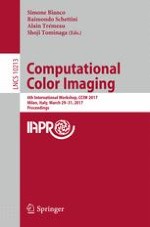2017 | Buch
Computational Color Imaging
6th International Workshop, CCIW 2017, Milan, Italy, March 29-31, 2017, Proceedings
herausgegeben von: Simone Bianco, Raimondo Schettini, Alain Trémeau, Shoji Tominaga
Verlag: Springer International Publishing
Buchreihe : Lecture Notes in Computer Science
